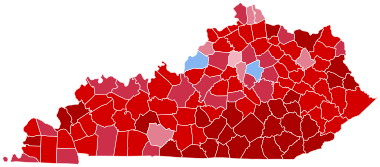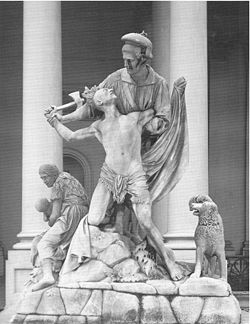Kentucky has whiskey and horses, a coal-miner’s daughter, Daniel Boone, and Muhammed Ali. I like whiskey, perhaps too much, and I wish all horses well. The legacy of coal is becoming more and more just that, a legacy. Muhammed Ali was The Greatest. He said so, and I agree.
I’ve never been to Kentucky (or for that matter its northern neighbors, Ohio and Indiana). I’ve been in Missouri across the Mississippi from Kentucky, and often enough to Tennessee, but never Kentucky. This is how Kris and I will look entering Kentucky for the first time, except that I’ll be carrying a fly rod instead of a rifle:

I hope we can get a horse at the Kentucky border. Otherwise Kris will have to walk.
As of the 2020 census, Kentucky has a population of 4.5 million. The population is 87.5 percent white, 8.5 percent black, and 4 percent everybody else. Less than 5 percent of the population is Hispanic or Latino. The consolidated city-county of Louisville, the state’s largest metro area, has a population of 782,969, with the city itself being 32.8 percent Black and 62.8 percent white. Consolidated Lexington, the second largest area, has a population of 322,570. The urban areas in Kentucky are seeing substantial growth, both economic and by population. The rural areas are generally suffering population losses, and they’re poor. As of 2019, Kentucky ranked among the poorest states, 44th, with a median annual family income of $52,295, just ahead of New Mexico and just behind Oklahoma.
In the 2020 presidential election, Kentucky voted 62 percent (1,326,646) to 36% (772,474) for Donald Trump. That’s pretty consistent with the other poor states, except New Mexico. The only two areas voting for Democrats were the two most populous counties, Fayette (Lexington–59.25% for Biden) and Jefferson (Louisville–59.06% for Biden). The Kentucky senators are Republicans Rand Paul and Mitch McConnell. Five Kentucky Congressmen are Republicans. The sixth, John Yarmuth, is retiring.

Interestingly, the Governor and Lieutenant Governor of Kentucky are Democrats, though nobody else in Kentucky appears to be. The Governor, Andy Beshear, won the 2019 election by fewer than 5,000 votes, and the election must have seemed a harbinger for the 2020 presidential election. Maybe it was, but not in Kentucky.
On the north, Kentucky is bordered by the Ohio River, on the east the Appalachians, on the west the Mississippi, and the south, well, nothing really. It’s just one of those arbitrary borders that separates two places, in this case Kentucky and Tennessee. The Appalachian/Cumberland Plateau takes up the eastern third of the state. Central Kentucky is apparently rolling hills covered with bluegrass pastures, while the northwest again becomes hilly. There’s some Mississippi River marshland down in the southwest, but not a lot.
There are two coal-producing areas, the Western Coal Field and the Eastern Coal Field. Butcher Holler is in the Eastern Coal Field, somewhere to the right of Lexington.
My daddy worked all night in the Van Lear coal mines
All day long in the fields a-hoein corn
Loretta Lynn, Coal Miner’s Daughter, 1969.

In addition to the Ohio, there are two other major rivers in Kentucky; the Cumberland wanders through Southeast Kentucky and North Central Tennessee, and the Kentucky runs from the Appalachians northwest through central Kentucky to the Ohio. There’s also a bit of the Mississippi. The Green River, the one in John Prine’s Paradise that Mr. Peabody’s coal train hauled away, is in the Western Coal Field.
The Green is supposed to be a pretty good smallmouth river.
For anglers, all of that stuff–except maybe the whiskey and the rivers–is of secondary importance to the real question: what kind of fish are there, and where. Kentucky is not a destination fishing state, at least for fly fishers, but in addition to the big three there are plenty of smaller rivers and streams. There are stocked and naturally reproducing trout, but they’re not native–though a lot of the fly fishing literature on the state is about where to find trout. Most of the guides in the state appear to be located near the Cumberland in Southern Kentucky–a dam tailwater–though there are also some guides out of Lexington. In addition to trout, there are catfish and sunfish, spotted bass, largemouth bass, and smallmouth bass. When we go next week, I hope we can try for smallmouth near Lexington, but it may still be too cold.
I recall that spotted bass used to be called Kentucky bass, but I had a hard time finding references to Kentucky bass on the internet.

In addition to Muhammed Ali and Loretta Lynn, Kentucky has had a penchant for producing (or being the home of) poets, especially reasonably important 20th Century poets. There are, in more or less historical order, Robert Penn Warren, Thomas Merton, Wendell Berry, and the recently deceased bell hooks. I can’t say that I’ve read anything by Warren except for All the King’s Men, which I vaguely recall is a novel, but Warren is the only person to have won a Pultizer Prize in both fiction and poetry. I’ve read a good bit of Merton, particularly The Seven Storey Mountain, which I vaguely recall is an autobiography. Reading his poetry–which isn’t always comprehensible–feels almost like reading parts of the Bible–which also isn’t always comprehensible. I’ve read almost none of bell hooks, who honestly until her recent death I hadn’t heard of. Old white Southerner, black feminist writer–I guess I’m not her target audience. I’ve reserved a couple of her books from our local library, but don’t have them yet.
Getting ready to go to Kentucky, I’ve read a good bit of Wendell Berry, who is, I think, peculiarly Southern in his dedication to agrarian values and anti-government convictions, and peculiarly un-Southern in his antiwar convictions. He also doesn’t seem to ever write a funny line, which seems peculiarly un-Southern except among evangelicals. The closest I could come to a funny line was this:
It may be that we can keep without harm some industrial comforts; warm baths in wintertime maybe, maybe painless dentistry.
From Our Deserted Country, Ten Essays.
I say it’s not funny. It’s kinda funny, but I suspect even in that Berry was mostly serious. In his photos he looks happy enough.

Besides the poets, I am old enough to have grown up revering Daniel Boone, but probably the folk hero Daniel Boone, not the actual Daniel Boone. The actual Boone never wore a coonskin cap, and no American hero has survived more historical (and ahistorical) revisions than Boone, culminating in the 1964 TV series Daniel Boone, starring Fess Parker.
I loved that show.
The actual Boone was born in 1735 to a Quaker family in Pennsylvania. After his father, Squire Boone, fell out with local Quakers, the Boones moved to North Carolina. Daniel married Rebecca in North Carolina in 1756, but he didn’t much cotton to farming. Even after marriage he spent most of his time on months- and even years- long hunts for pelts for the fur trade. He wandered as far from North Carolina as Florida, and purchased land there. At some point he wandered into Kentucky.
In the popular imagination, Boone opened Kentucky for settlement. He first entered Kentucky in 1767, and in 1769 returned and spent two years exploring. That’s two years out gallivanting. There is a possibly apocryphal tale of Boone returning from a long hunt to find that Rebecca had a new daughter fathered by Boone’s brother. Possibly apocryphal, possibly true. If true, Boone apparently took it in stride.

Boone famously trail-blazed the Wilderness Road from Virginia to Tennessee through the Cumberland Gap. Boone entered Kentucky during a peculiarly violent period of American history. Beginning with the Revolutionary War and continuing through the Battle of Fallen Timbers in 1794, there was constant warfare and the threat of warfare with the British and the Northwestern tribes. Boone had the reputation of an Indian fighter, and he was certainly involved in the Northwest Indian War, but late in life Boone said that he had only ever killed three Indians. He was a brilliant pathfinder, a respected leader, a great hunter, but not the rippin’est, roarin’est, fightin’est man the frontier ever knew. He was a colonel in the state militia, at a time when because of the constant threat of local war the rank meant something.
My favorite Boone quote was that he was never lost, but that he was misplaced for a few days from time-to-time.
In 1799 Boone moved west to Missouri because he went broke in Kentucky. He had claimed a lot of land in Kentucky, but didn’t really have the temperament to be a land investor, and didn’t have the resources to hold all of his land together.
In 1820 he was 85 when he died in Defiance, Missouri. He was a legend in his own time, largely because of a contemporary popular pamphlet. Later the penny press took up Boone, and created the folk-hero that lasted through my childhood infatuation with the Boone portrayed by Seth Parker.
D. Boon cilled a bar and swung through the forest on grape vines.

In the 1800s Wisconsin historian Lyman Draper collected Boone’s papers and the oral remembrances of his descendants and his contemporaries, so unlike many historical figures we know a lot about Boone. Boone himself wasn’t shy about telling his story, and unlike many, he was pretty reliable. Later still there would be largely discredited revisionist theories concerning Boone, that pronounced that most settlers of Kentucky came down the Ohio River, not across the Wilderness Road, or that Boone was only the lackey of real estate investors who told him what to do, or that in some other way Boone should get no credit for the settlement of Kentucky. That, apparently, is about as bad of history as the folk tales, even though it was propagated by academic historians.
Interestingly, the folk-hero Boone is the subject of an early statue removal, in this case in the nation’s capital. A marble statue of The Rescue, generally believed to be Boone rescuing his family, was displayed in the Capital from 1853 until 1959, more than 100 years, until it was removed during building work and never put back. By 1959 it was the subject of considerable controversy, and I figured that they did the building work just to get rid of the statue, along with the statue of Christopher Columbus on the other side of the stairway (which is also still in storage).

Boone was 43 by the time he made it to Kentucky. For my first trip to Kentucky I’m a bit older than that, but instead of founding Boonesborough, I can make a motel reservation. In any event, I’m just in it for the whiskey. I mean the fish.























